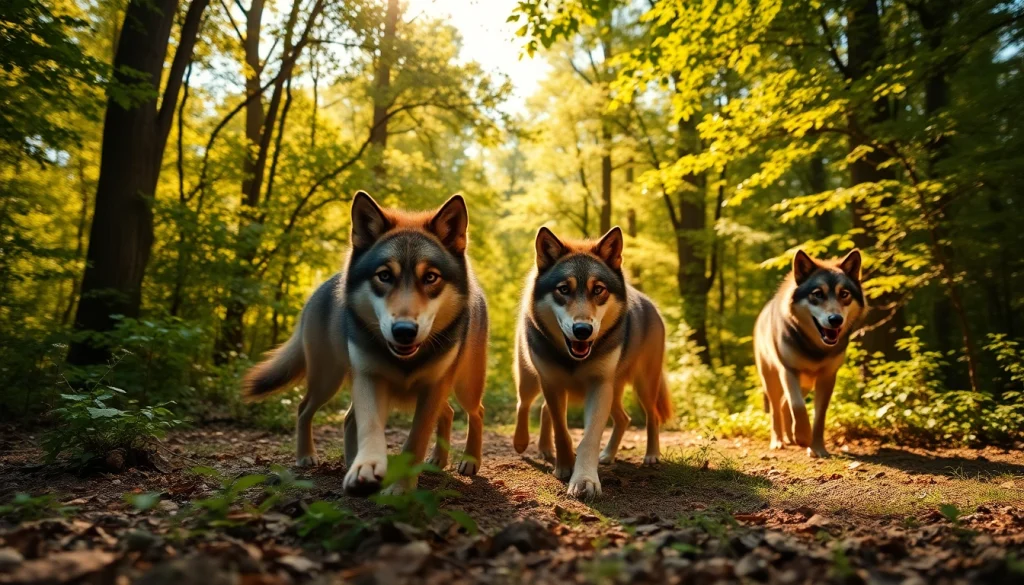
Understanding Wolves: Nature’s Fascinating Creatures
Biology and Behavior of Wolves
Wolves, known scientifically as Canis lupus, are mesmerizing creatures that play a crucial role in the ecosystems where they reside. With their distinct physical characteristics, such as sharp teeth and keen senses, wolves are superbly adapted for survival in the wild. Their legendary sense of smell can detect prey from miles away, while their acute hearing enables them to pick up sounds that humans cannot. This combination of senses introduces us to the biology of wolves, revealing their hunting prowess and social survival strategies.
Social behavior in wolves is just as notable as their biology. Wolves exhibit complex behaviors and communicate through vocalizations, body language, and scent marking. Vocalizations include howls, barks, and growls. Not only do they communicate with their pack members, but howls serve the function of maintaining contact with other wolves, asserting territory, and coordinating hunts. Wolves are primarily nocturnal hunters, which aligns with their prey’s behavioral patterns, enhancing their success rate during hunts.
The Social Structure of Wolf Packs
The social structure of a wolf pack is sophisticated, typically consisting of a family unit that includes an alpha male and female, their offspring, and sometimes other adult wolves. This hierarchical structure plays a critical role in the survival of the pack as it promotes cooperation during hunts and assures a stable breeding environment. Only the alpha pair breeds, which helps regulate the population and maintains the social order within the pack.
Every member of the pack has a role. For instance, lower-ranking wolves may help raise the younger pups or assist in hunting activities, showcasing a cooperative spirit that is vital for their communal survival. This social structure not only captivates scientists and wildlife enthusiasts but also fosters a sense of unity and purpose among individual wolves. Through collaboration, wolves thrive in diverse habitats, ranging from snowy forests to arid tundras.
Wolves in Different Ecosystems
Wolves occupy various ecosystems across the globe, from North America and Europe to Asia. Their presence is pivotal in maintaining ecological balance. In regions such as Yellowstone National Park, wolves have been instrumental in controlling the populations of herbivores like elk, which, when left unchecked, can overgraze vegetation and lead to soil erosion and loss of biodiversity.
The reintroduction of wolves to Yellowstone in the 1990s exemplifies their role as a keystone species. The wolves helped restore balance to the ecosystem, allowing for the recovery of vegetation and the return of other wildlife species. This phenomenon illustrates the interconnectedness of all living things and emphasizes the importance of wolves to their habitats.
Conservation Efforts: Protecting Wolves in the Wild
Current Threats to Wolf Populations
Despite their ecological significance, wolves face numerous threats that jeopardize their populations and the biodiversity of their ecosystems. Habitat loss due to urban development, agriculture, and deforestation is one of the most pressing issues. Fragmentation of their habitat limits their ability to hunt, breed, and migrate, ultimately leading to decreased genetic diversity and increased vulnerability.
Additionally, human-wildlife conflict often arises, particularly in areas where livestock farming is prevalent. Wolves are often viewed as threats to livestock, resulting in retaliatory killings and culls. Poaching and illegal hunting further exacerbate the decline in wolf numbers. Understanding these threats is paramount when developing effective conservation strategies that ensure the survival of these magnificent creatures.
Successful Conservation Programs
Fortunately, several successful conservation programs have demonstrated that well-managed initiatives can lead to the resurgence of wolf populations. Programs in the United States, Europe, and Canada have focused on habitat restoration, legal protections, and community awareness campaigns. For instance, the Recovery Plan for the Gray Wolf in the United States has seen populations rebound significantly.
One standout example is the Minnesota wolf population, which has stabilized due to active management practices, including public education and collaborative conflict mitigation strategies with local farmers. Programs that engage the public, allowing them to contribute to monitoring efforts and understanding wolves’ ecological roles, have proven to be effective in promoting coexistence between humans and wolves.
How Individuals Can Help
Every individual can play a role in the conservation of wolves and their habitats. Simple actions, such as supporting conservation organizations, participating in wildlife tours, and spreading awareness about the importance of wolves, can create a ripple effect of positive change. Engaging in local advocacy efforts or campaigns aimed at protecting wolf habitats can also empower citizens to be stewards of the environment.
Moreover, responsible tourism and philanthropy can contribute funding to ongoing conservation efforts. Sharing one’s own experiences through social media and educational platforms, like www.sudswild.com, helps to inspire others by highlighting the beauty and importance of our natural world.
Wolves in Culture: The Symbolism and Myths
The Role of Wolves in Folklore
Wolves have long held a significant place in human mythology and folklore, often viewed as symbols of strength, loyalty, and ferocity. Ancient cultures revered them, embedding them in legends that celebrate their hunting skills and social structures. In various Native American tribes, wolves are depicted as teachers or guides, embodying the spirit of nature and emphasizing cooperation.
Contrastingly, in European folklore, wolves have sometimes been depicted as villainous creatures, manifesting fear in tales like “Little Red Riding Hood.” This dichotomy highlights humanity’s complex relationship with wolves—while they can be seen as fearsome predators, they evoke admiration and respect for their tenacity and social behavior.
Wolves in Literature and Film
Literature and film have played pivotal roles in shaping modern perceptions of wolves. From Jack London’s “White Fang” to more contemporary portrayals in films like “The Grey,” wolves are often depicted as both allies and adversaries to humanity. These narratives encourage deeper connections with the wild and challenge audiences to view wolves through a more nuanced lens.
Documentaries showcasing the lives of wolves, such as “The Last Wolf,” have raised awareness about their ecological significance and conservation needs. By highlighting their extraordinary behaviors and social dynamics, such media can shift public perception away from fear to fascination—a vital step toward generating support for their protection.
Modern Perceptions and Misunderstandings
Misunderstandings about wolves persist in modern society, often perpetuated by myths and misinformation. Many people associate wolves primarily with danger, neglecting to acknowledge their critical role in preserving ecosystem health. This stigma can lead to unnecessary fear and hatred, hindering conservation efforts.
Education plays a vital role in counteracting these misconceptions. By informing communities about the ecological importance of wolves and encouraging positive interactions, we can nurture a more harmonious relationship between humans and wildlife. Initiatives aimed at promoting factual understanding through workshops and educational programs are essential for bridging this gap.
Experiencing Wolves: Wildlife Tours and Education
Best Destinations for Wolf Watching
For those interested in experiencing wolves in their natural habitat, several prime destinations around the globe offer unique wildlife tours. Places like Yellowstone National Park, where wolves once roamed free, are now hot spots for wolf watching, particularly in the Lamar Valley. Guided tours provide opportunities to observe their behavior while learning about their ecology.
In addition to Yellowstone, other notable locations include Wood Buffalo National Park in Canada and La Leona in Argentina, both fostering environments conducive to wolf sightings. These tours emphasize responsible interactions with wildlife and help to fund conservation efforts while giving participants indelible memories of encountering these majestic creatures.
Educational Opportunities and Workshops
Various organizations conduct workshops and educational opportunities where participants can learn about wolves extensively. These programs often include guest speakers, hands-on experiences, and field trips aimed at offering insights into the wolves’ behaviors, social structures, and ecological contributions. Engaging directly with experts fosters a deeper appreciation for these creatures and encourages ongoing involvement in conservation efforts.
Educational institutes and wildlife organizations frequently collaborate to design immersive educational experiences. By involving local communities, these initiatives ensure that conservation efforts are community-centered, encouraging greater support and participation from those living in proximity to wild wolves.
How to Conduct Responsible Viewing
Participating in wildlife tourism comes with the responsibility of maintaining the well-being of animals and their habitats. Responsible viewing practices include maintaining safe distances, using binoculars for observation, and minimizing noise to avoid startling wildlife. Adhering to guidelines set by tour operators ensures that wildlife experiences are ethical and sustainable.
Additionally, visitors are encouraged to educate themselves about the environment, as understanding the surroundings enhances the overall experience. Engaging with local wildlife experts can provide valuable insights and a deeper appreciation for the delicate balance within ecosystems. Thus, responsible wildlife viewing not only enriches the viewer’s experience but contributes positively to conservation efforts.
Engagement Through Art: Photography and Storytelling
The Power of Wildlife Photography
Wildlife photography serves as a powerful tool for emphasizing the beauty and importance of wolves within their ecosystems. Professional wildlife photographers strive to capture the essence of these magnificent creatures, showcasing their behaviors, habitats, and interactions with other wildlife. The stunning visuals produced not only engage the public but also foster empathy and an appreciation for conservation.
Artistic expression through photography can evoke emotions and drive action for conservation initiatives. Through exhibitions and social media platforms, powerful imagery can communicate urgent messages about the challenges faced by wolves and their ecosystems, mobilizing supporters and drawing attention to issues that require action.
Storytelling through Research and Observation
Another compelling way to engage with the topic of wolves is through storytelling that combines research and first-hand observation. Scientists and wildlife enthusiasts have the opportunity to narrate their experiences and findings through blogs, articles, and engaging video content. Personal stories, anecdotes, and compelling narratives resonate with audiences and humanize the often misunderstood creatures while making complex research accessible.
Storytelling cultivates connections among diverse audiences, bridging gaps between scientific research and public perception. Sharing these narratives fosters community involvement in conservation and inspires collective action to protect wolves and their habitats.
Sharing the Wild at www.sudswild.com
Platforms like www.sudswild.com provide an avenue for sharing stories, experiences, and insights about wildlife. This online community encourages individuals to come together, learn, and raise awareness regarding the importance of wildlife conservation, specifically focusing on wolves and their fascinating nature.
Sharing research, imagery, and personal experiences regarding wolves allows for a collective effort to nurture a deeper respect for these creatures, ultimately fostering a more harmonious relationship between humans and the natural world.






